There’s more than fresh air in Tasmania – there’s also an abundance of fresh produce and seafood. Jennifer Johnston shares some of her favorite tasting experiences around Australia’s smallest state.
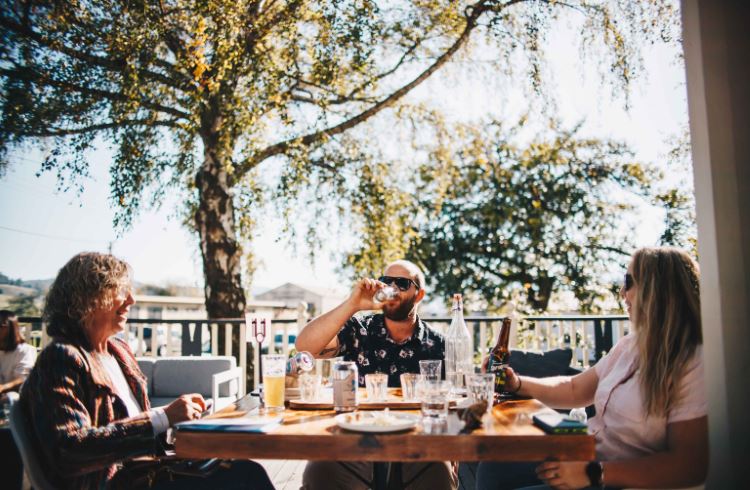 Photo © Wandering Trout Taphouse - Jasper da Seymour
Photo © Wandering Trout Taphouse - Jasper da Seymour
Tasmania has long been a destination for those who love wild and untamed regions. There are more than 1,739mi (2,800 km) of hiking trails and coastal treks to suit all sorts of adventure seekers. As a regular explorer on these trails, I know expelling energy creates an appetite. Thankfully Tasmania is a foodie’s paradise.
The Cradle to Coast Tasting Trail
My eldest son James and I are staying in a cabin overlooking Mount Roland, a 45-minute drive from Cradle Mountain in central Tasmania. We hike various trails on Cradle Mountain and drive back to the cabin through small regional towns, some with barely more than a few shops on their main street.
After one particularly strenuous day – my son climbed the summit of Cradle Mountain 5,069ft (1,545m), a six-hour effort, and I clambered to Marion’s Lookout 4,015ft (1,224m) – we’re famished. We notice the Wandering Trout Taphouse on Mole Creek’s main street is open. Inside the beautifully restored historic building we choose a table with views of the Great Western Tiers – a spectacular set of rugged mountain bluffs on the edge of Tasmania’s central highlands. You can never get enough of Tasmania’s craggy mountains.
Owner and chief brewer Justin MacLeod welcomes us. “Our regionally unique brews are brewed in small batches using pure rainwater,” he proudly declares. My son, who likes beer, orders a ‘Belczech’. I’m more of a cider gal so I try an on-tap Pagan Cider. For the non-beer drinkers, they also sell honey ale, mead, and a selection of Tasmanian wines.
Their menu looks tempting. James selects the lemongrass and chili wings, and I order a Vietnamese salad. I wasn’t expecting world-class food in a small regional town and express my delight to Justin. “I like food and in small towns like Mole Creek decent food is hard to come by,” he says. “I created a menu that changes regularly to keep our guests happy.”
A sign at the bar indicates the craft brewery is on the Cradle Tasting Trail. Wanting to know more, we grab a map from a side table. We learn the trail features the region’s best producers, with choices ranging from sweet berries to truffles, cider to ice cream, honey to pickled onions, hazelnuts, wine and whiskey, craft gin distillers and fresh seafood like oysters, lobsters, and salmon. The trail meanders for around 135mi (218km) beginning south of Launceston on the island’s east and finishing in the top northwest corner in Smithton.
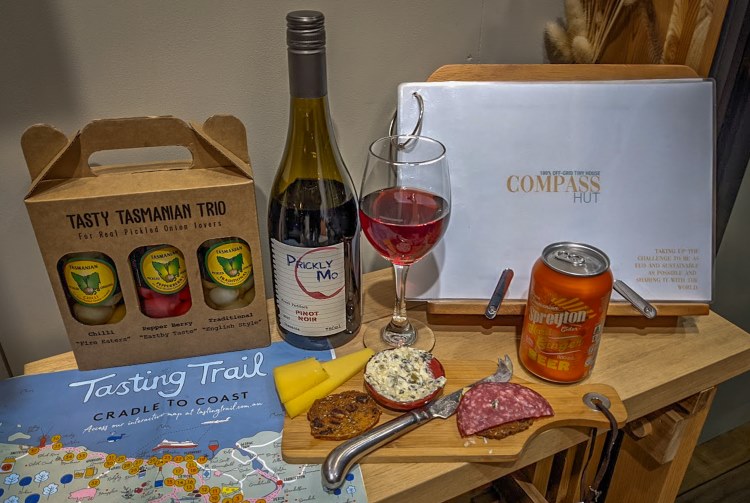
Tasmania’s Northwest region is vast. It includes the towns of Devonport, Deloraine, Latrobe, Burnie, the Cradle Mountain National Park, and many small towns in between. On my next visit to Tasmania, I don’t have time to tick everyone off the tasting trail. So, I opt for what I like. As a chocolate lover, Anver’s Chocolate factory on the Bass Highway between Devonport and Launceston is one of my stops. Anvers café, coffee shop, factory, and museum are housed inside a 1928 Californian bungalow-style building. I wander through the museum, peering like a voyeur through a glass pane into the factory where staff wearing aprons and hair nets create chocolate, truffles, and fudge. At the nearby tasting center I sample a few – the orange fudge is the best I’ve ever tasted. I leave with my bag filled with Anvers goodies.
I’d booked two nights at the Ship Inn in Stanley, a seaside town in the far northwest. Overlooking Bass Strait and with The Nut, a huge volcanic plug jutting out from the ocean, Stanley is not only picturesque, but also an ideal base to explore more of the Tasting Trail. My first call is in nearby Smithton at Tarkine Fresh Oysters. The oysters grow and fatten in more than 80 hectares (200 acres) of cool temperate waters.
Next is Mawbanna to visit Blue Hills Honey and sample its award-winning Leatherwood Honey. Then it's a slight detour down Myrtle Grove Road to KimchiMe to taste Tasmania’s freshest organic kimchi, hand-made by Sue Glynn. Born and raised in South Korea, Sue wants everyone to appreciate the health benefits of kimchi.
Tasmania’s seafood trails
Tasmania is surrounded by pristine oceans, and the seafood living in those waters is some of the finest in Australia. Think abalone, rock lobster, mussels, scallops, and deep-sea fish. The coastline features oyster farms where freshly shucked oysters are the order of the day in places like Smithton (on the Cradle Tasting Trail), Dolphin Sands in the southeast, Bruny Island on the southern end, and Coles Bay on the east coast.
Also on Tassie’s east on the Bicheno Foreshore, you’ll find freshly caught southern rock lobster. Inside the Lobster Shack, a boutique waterfront café co-owned by Marcus and Sara Walkem, you can indulge in an ocean-to-plate experience on the front deck overlooking the harbor. You can select your own live lobster from tanks, or order a lobster roll, seafood platter, scallops, or freshly battered fish and crispy chips complimented by an east coast wine. Marcus’s love for seafood comes from a pedigree fishing family. He’s a commercial fisherman who trawls the East Coast waters fishing sustainably. (Produce is seasonal.)
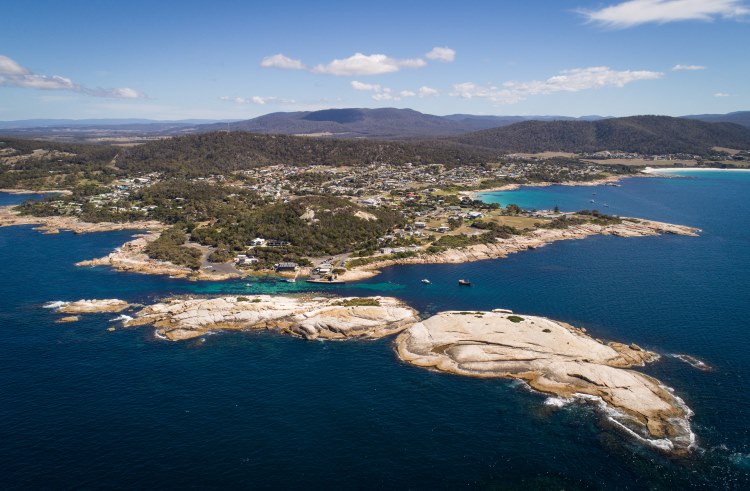
Hobart and surrounds
The Agrarian Kitchen
In December last year, I did a hands-on cooking class at The Agrarian Kitchen in New Norfolk, about a 35-minute drive northwest of Hobart. This full-day experience included a delicious lunch, cooked by the students under the watchful eye and expert tutelage of Rodney Dunn.
In 2008, Rodney and his wife Séverine Demanet began The Agrarian Kitchen Cooking School from their home on the family farm in New Norfolk. Passionate about fresh produce and sustainability, they created a unique paddock-to-plate experience. In 2017, they opened The Agrarian Kitchen restaurant in town in the vacant Bronte Building – once the State’s mental asylum. In 2022, they repurposed a vacant space within the complex for their new cooking school.
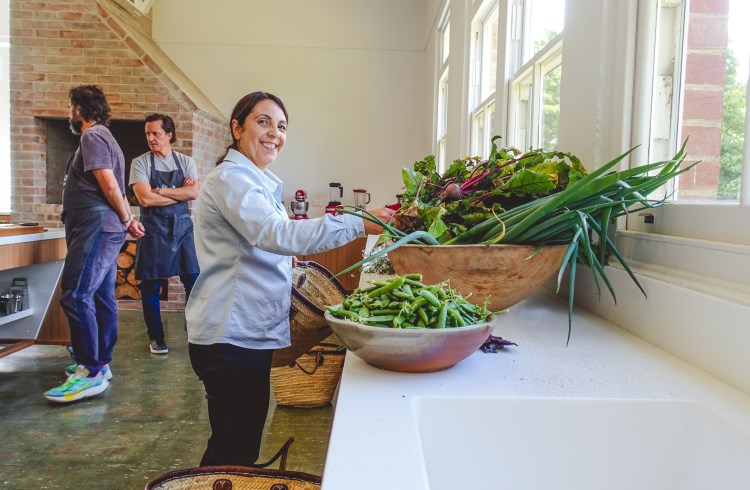
At the start of the cooking class, Rodney announces, “Today is about freeing you of a set recipe and reconciling with what is in season.” He confesses he has a sweet tooth. “I always look at dessert on the menu first.” I feel I’ve found my twin. He informs our class of 11, “The dessert we’re making today ticks all the boxes!” There are three components to the Angel Pie dessert: a citrus lemon curd, a brown sugar meringue, and some shortcrust pastry discs. “That is your crescendo,” Rodney declares. And he wasn’t wrong.
We tour the nearby garden (originally the mental asylum’s exercise yard) plucking fresh produce. Back inside the kitchen for the next four hours, over much laughter and conversation, we create seven dishes following Rodney’s recipes.
The Source at MONA
Whether you’re an art connoisseur or a voyeuristic amateur, a visit to Hobart should include a trip to the Museum of Old and New (MONA). Established by David Walsh, to house his collection of art, MONA is now Australia’s largest private museum – and the second most-visited tourist attraction in Tasmania (after Cradle Mountain.) Located on a peninsula in the Hobart suburb of Berriedale, it opened in 2011.
At MONA, there are many food and drink venues, including The Source restaurant.
Its website describes The Source as a ‘temple to seasonal Tasmanian dining’. Only, this temple provides an otherworldly experience. The spectacular dishes are the creations of Executive Chef Vince Trim. The food is seasonal, and every few months Trim reinvents the menu.
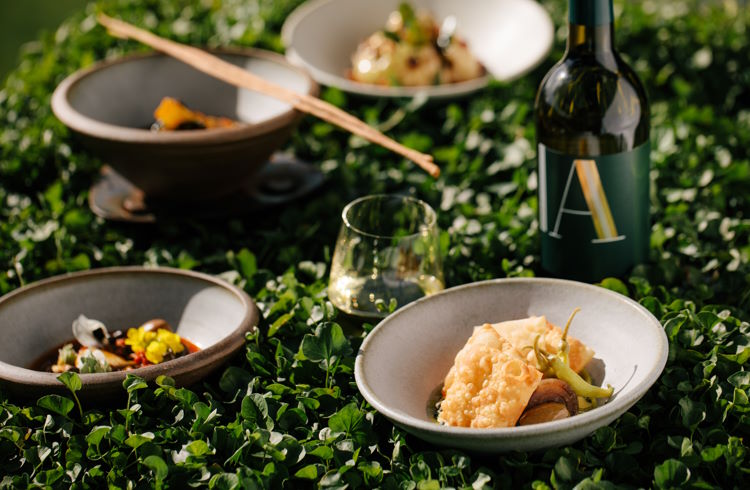
The vibe inside is opulent. Outside are expansive river views. On certain occasions, there’s a unique, living moss-and-herb dining table set up, covered with foliage guests can eat, like nasturtiums, dried kimchi, and seaweed. My friend’s order of oysters arrives on a golden platter with molded holes for each shell to sit in. Dramatic and memorable, just like MONA.
It's easy to see why I’ve never left the Apple Isle feeling underfed.
Related articles
Simple and flexible travel insurance
You can buy at home or while traveling, and claim online from anywhere in the world. With 150+ adventure activities covered and 24/7 emergency assistance.
Get a quote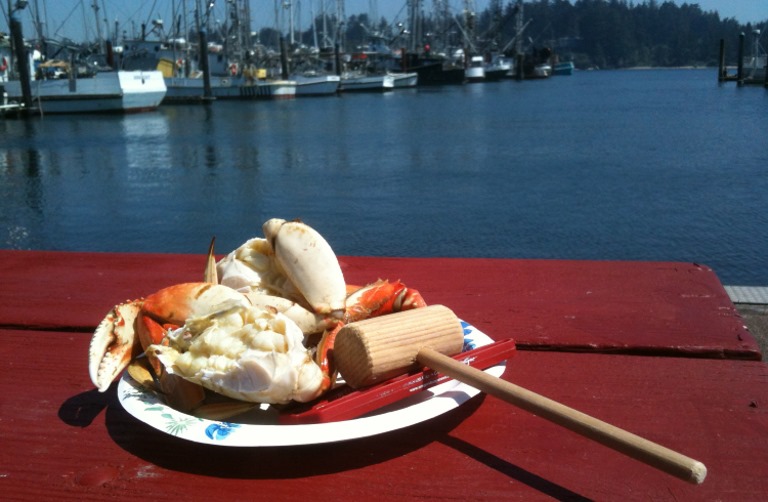

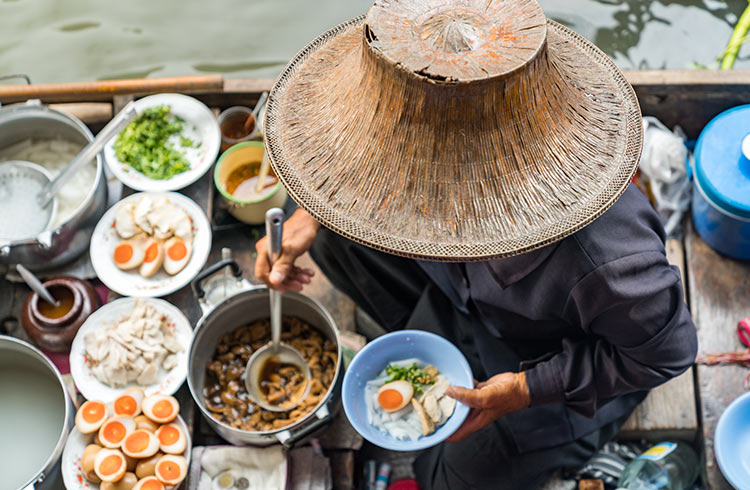
No Comments